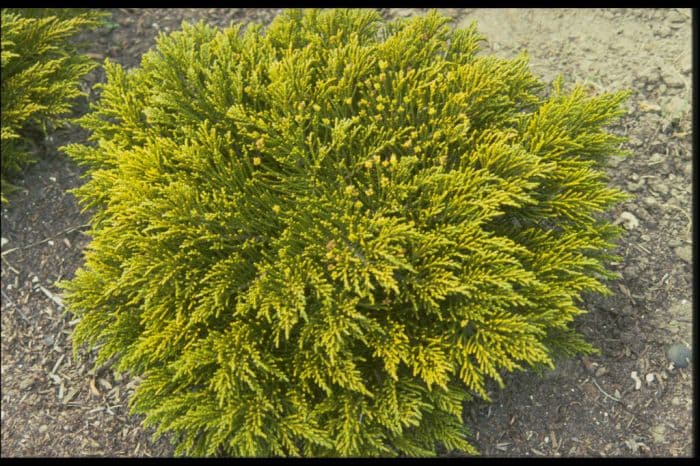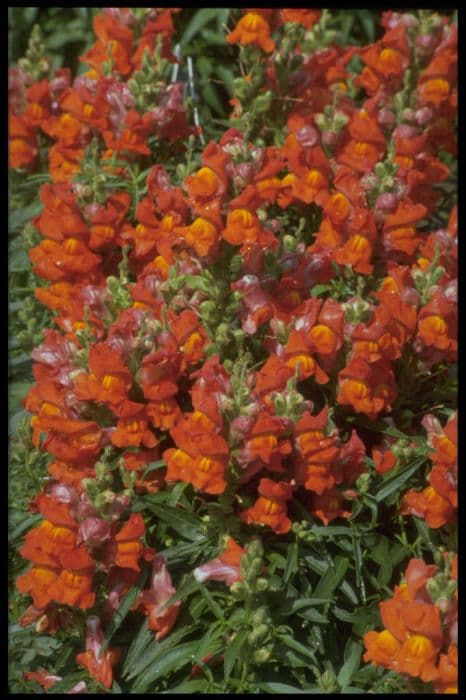Shrubby Veronica Hebe ochracea 'James Stirling'

ABOUT
Hebe ochracea 'James Stirling' is a striking evergreen shrub known for its unique foliage and form. The plant boasts small, scale-like leaves that tightly cling to its branches, creating a neat, almost whipcord appearance. These leaves are a standout feature, exhibiting an eye-catching ochre-yellow color that can add a vibrant touch to any garden setting. When the seasons change, the foliage may subtly alter in hue, adding to its visual appeal. Beyond its foliage, this particular Hebe variety can produce blooms, although it is primarily grown for its colorful leaves. The flowers, when they do appear, are delicate and may be on the smaller side, typically in shades that complement the foliage. The overall habit of 'James Stirling' is compact and rounded, making it an excellent choice for adding structure to garden compositions, whether planted in mass, used as a low hedge, or featured as an individual specimen. It is praised for its resilience and ability to maintain its composure in a variety of garden settings, showcasing its form and texture throughout the year. As with most Hebes, 'James Stirling' prefers well-drained soil and can tolerate coastal conditions, making it a versatile option for gardeners in various climates. It's an attractive and hardy addition to the plant palette of any gardener looking to add a long-lasting splash of color and interest to their landscape.
About this plant
 Names
NamesFamily
Plantaginaceae
Synonyms
Shrubby Veronica, Hebe 'James Stirling'
Common names
Hebe ochracea 'James Stirling'.
 Toxicity
ToxicityTo humans
The common name for Hebe ochracea 'James Stirling' is Shrubby Veronica. There is limited information specifically on the toxicity of Shrubby Veronica to humans. Hebes, in general, are not well-known for being poisonous, and there is no widespread evidence to suggest that this specific cultivar, Hebe ochracea 'James Stirling', has toxic properties that would cause harm to humans if touched or ingested. Nevertheless, it is always prudent to exercise caution and keep plants out of reach of children, who may inadvertently consume plant parts. If any ingestion does occur, monitoring for gastrointestinal discomfort, skin irritation, or allergic reactions and seeking medical advice would be appropriate.
To pets
The common name for Hebe ochracea 'James Stirling' is Shrubby Veronica. Similar to its effects on humans, there is no specific information about the toxicity of Shrubby Veronica to pets. The Hebe genus is not typically listed among common toxic plants for pets, suggesting that Shrubby Veronica may not be particularly harmful. However, as with any non-food plant, ingestion by pets, especially in large quantities, could potentially result in mild gastrointestinal upset. Symptoms could include vomiting and diarrhea. To be cautious, it's best to keep Shrubby Veronica out of reach of pets and consult a veterinarian if your pet is showing signs of distress after consuming any part of the plant.
 Characteristics
CharacteristicsLife cycle
Perennials
Foliage type
Evergreen
Color of leaves
Green
Flower color
White
Height
1-2 feet (30-60 cm)
Spread
1-2 feet (30-60 cm)
Plant type
Shrub
Hardiness zones
8
Native area
New Zealand
Benefits
 General Benefits
General Benefits- Low Maintenance: Hebe 'James Stirling' is known for being easy to care for, requiring minimal pruning and upkeep.
- Drought Tolerance: Once established, it can tolerate periods of low water, making it suitable for dry climate gardens.
- Year-Round Interest: With its evergreen foliage, it provides visual interest throughout the year.
- Attracts Wildlife: The flowers of Hebe 'James Stirling' can attract bees and other beneficial pollinators to the garden.
- Compact Size: Its small and compact habit makes it an excellent choice for borders, containers, and small gardens.
- Versatility: It can be used in various landscape designs, including rock gardens, coastal gardens, and formal beds.
- Color Variation: Offers subtle foliage color changes throughout the seasons, from yellow-green to bronze tones in colder weather.
- Wind Resistance: Its sturdy nature means it can withstand windy conditions, suitable for exposed sites.
- Fast Growing: It has a relatively quick growth rate, allowing gardens to establish and fill out quickly.
 Medical Properties
Medical PropertiesThis plant is not used for medical purposes.
 Air-purifying Qualities
Air-purifying QualitiesThis plant is not specifically known for air purifying qualities.
 Other Uses
Other Uses- Education and Research: 'James Stirling' can be used in botanical education to help students learn plant identification and understanding of plant habits and forms in different environments.
- Art and Photography: This plant, with its fine foliage and contrasting colors, is often used as an attractive subject for botanical illustration, art or photography projects.
- Eco-friendly Packaging: The sturdy nature of the shrub can lead to research into the potential for turning its fibre into biodegradable packaging material.
- Natural Dyes: The leaves and flowers may be used to extract natural dyes for use in textiles or crafts.
- Companion Planting: 'James Stirling' can be planted as a companion plant in gardens to help deter pests with its hardy nature, without using chemical pesticides.
- Soil Erosion Control: Its dense growing habit helps to prevent soil erosion in sloped gardens and landscapes.
- Landscape Modeling: Miniature or model landscapes can utilize this plant due to its small size and shrub-like appearance for realistic scenery.
- Cultural Significance: 'James Stirling' can have cultural and historical importance in specific regions, highlighting the native flora through garden displays.
- Wildlife Shelter: Its dense foliage provides shelter and nesting sites for birds, beneficial insects, and small mammals in urban and suburban gardens.
- Acoustic Barriers: Planting 'James Stirling' hedges in dense rows can be an effective natural sound barrier, reducing noise pollution.
Interesting Facts
 Feng Shui
Feng ShuiThe plant Hebe is not used in Feng Shui practice.
 Zodiac Sign Compitability
Zodiac Sign CompitabilityThe plant Hebe is not used in astrology practice.
 Plant Symbolism
Plant Symbolism- Youth: The genus Hebe is named after the Greek goddess of youth, reflecting the plant's fresh and youthful foliage.
- Everlasting Love: As an evergreen shrub, Hebe ochracea 'James Stirling' can represent enduring and constant affection, much as it retains its leaves throughout the seasons.
- Protection: Evergreen plants like this Hebe species are often thought to symbolize protection and are commonly used in gardens to create a feeling of safety and sanctuary.
- Resilience: Able to withstand different growing conditions, Hebe symbolizes the ability to adapt and persevere through challenges.
- Beauty: With its attractive foliage, the plant is often associated with natural beauty, emphasizing an appreciation for aesthetic qualities.
 Water
WaterThe shrubby Veronica 'James Stirling' should be watered thoroughly when the top inch of soil feels dry to the touch, which typically means once a week during its growing season, with less frequent watering required during the winter months. The ideal method is to water at the base of the plant to avoid wetting the foliage, which can help prevent diseases. Each watering should be deep enough to soak the roots, which can be achieved by using approximately 1-2 gallons of water, ensuring even distribution within the plant's root zone.
 Light
LightShrubby Veronica 'James Stirling' thrives best under full sun to partial shade conditions. Ideally, it should be placed in a spot where it can receive at least six hours of direct sunlight daily while being protected from the harsh afternoon sun, especially in hotter climates. Providing bright, indirect light will promote healthy growth and flowering.
 Temperature
TemperatureShrubby Veronica 'James Stirling' can tolerate a range of temperatures, but it performs best when the temperature is between 50-75°F. It can survive temperatures as low as 30°F and as high as 85°F, but prolonged exposure to extremes outside of its ideal range can stress the plant. Consistent temperatures within this range support the healthiest growth for 'James Stirling.'
 Pruning
PruningShrubby Veronica 'James Stirling' should be pruned to maintain shape and encourage bushier growth, generally once a year in the late winter or early spring before new growth begins. Deadheading spent flowers can also promote further blooming throughout the growing season. Pruning is also a good time to remove any damaged or diseased stems to keep the plant healthy.
 Cleaning
CleaningAs needed
 Soil
SoilThe best soil mix for Shrubby veronica is one that is well-draining and fertile, with a mixture of loam, peat, and coarse sand or perlite. It prefers a slightly acidic to neutral pH, ideally between 6.5 and 7.5.
 Repotting
RepottingShrubby veronica typically needs repotting every 2 to 3 years or when it becomes root-bound. Spring is the best time to repot this plant for minimal stress and optimal growth.
 Humidity & Misting
Humidity & MistingShrubby veronica does well in moderate humidity levels, but it's adaptable and can handle the average home humidity. No specific humidity requirements are necessary beyond typical indoor conditions.
 Suitable locations
Suitable locationsIndoor
Place Shrubby veronica in bright, indirect light, and avoid dry air.
Outdoor
Plant in a sheltered spot with morning sun and well-draining soil.
Hardiness zone
8-11 USDA
 Life cycle
Life cycleHebe 'James Stirling' begins its life cycle when a seed germinates, usually in the spring, given appropriate moisture and temperature conditions. The seedling grows into a juvenile plant, establishing a root system and developing its first leaves. As it enters the vegetative stage, it develops a woody stem and evergreen foliage, growing into a small, compact shrub with a distinctive foliage color that ranges from yellow-green to orange-brown. Following the vegetative phase, it reaches maturity and begins the reproductive stage, where it produces small white or pale blue flowers in the summer, attracting pollinators. After pollination, the flowers develop into small capsules that contain the seeds, thus completing the reproduction phase. Eventually, as the plant ages, it enters senescence, where growth slows down before the plant dies, although Hebe 'James Stirling' can live for many years with proper care.
 Propogation
PropogationPropogation time
Spring-Early Summer
Propogation: Hebe 'James Stirling', often called Shrubby veronica, is best propagated through semi-hardwood cuttings. This method is generally conducted in late summer when the current season's growth has begun to mature but is not yet fully woody. Cuttings should be taken from healthy plants, approximately 4 to 6 inches (10 to 15 centimeters) in length, with several leaves left at the top and the lower leaves removed. The cut end can be dipped in rooting hormone to encourage root development before it is inserted into a well-draining potting mix. It's important to keep the soil moist but not waterlogged and to provide a warm, sheltered environment, such as inside a propagator or under a plastic cover, to maintain humidity while the cuttings root. With proper care, roots will form within a few weeks, and the new Shrubby veronica plants can be transplanted to a permanent location.









